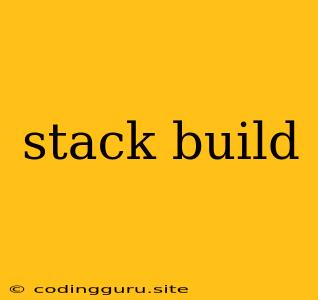What is a Stack Build?
The term "stack build" often refers to the process of creating a software environment or application by layering different components, known as a stack, on top of each other. This process involves selecting and configuring specific technologies and frameworks, such as programming languages, databases, web servers, and operating systems, to meet the requirements of a particular project.
Stack build is a fundamental concept in software development, especially in areas like web development, mobile development, and data science. It allows developers to create robust and efficient solutions by leveraging the strengths of different technologies.
Why is Stack Build Important?
Stack build is crucial for several reasons:
- Efficiency: By using pre-built components, developers can save time and effort compared to building everything from scratch.
- Consistency: A stack build helps ensure that all components work together seamlessly, leading to a more stable and predictable application.
- Scalability: Stack builds are designed to handle increasing workloads and traffic, making applications more scalable and reliable.
- Security: Using well-established technologies in a stack build improves security by incorporating pre-built security features and best practices.
- Community Support: Popular stack builds have a large community of developers, providing access to resources, documentation, and support.
Examples of Popular Stacks
There are numerous stack builds available, each catering to specific needs and preferences. Here are some popular examples:
- LAMP Stack: This classic stack build consists of Linux, Apache web server, MySQL database, and PHP scripting language. It's widely used for web development and is particularly suitable for content management systems (CMS) and e-commerce platforms.
- MEAN Stack: This stack build utilizes MongoDB, Express.js, AngularJS, and Node.js. It's a popular choice for building dynamic web applications and APIs using JavaScript.
- MERN Stack: Similar to the MEAN Stack, MERN uses React instead of AngularJS, making it ideal for creating user interfaces (UI) and single-page applications (SPAs).
- Ruby on Rails: This framework combines Ruby programming language with a set of libraries and tools, making it efficient for building web applications.
Steps Involved in Stack Build
The process of stack build typically involves the following steps:
- Define Project Requirements: Identify the specific features, functionalities, and technologies needed for your project.
- Select Stack Components: Choose the appropriate technologies based on project requirements, budget, and team expertise.
- Set Up Infrastructure: Configure the necessary servers, databases, and operating systems.
- Install Dependencies: Install the required libraries, frameworks, and tools for your chosen stack.
- Develop Application: Create the core application logic and features using the selected technologies.
- Testing and Deployment: Thoroughly test the application and deploy it to a live environment.
Tips for Successful Stack Build
Here are some helpful tips for a successful stack build:
- Choose the Right Stack: Research different stack builds and carefully evaluate their strengths and weaknesses before selecting the one that best suits your project.
- Consider Security: Implement security best practices and consider using secure technologies throughout the stack build.
- Document Everything: Document your stack configuration, dependencies, and development processes for future reference and maintenance.
- Stay Updated: Technologies evolve constantly, so keep yourself informed about updates and advancements in your chosen stack build.
Challenges of Stack Build
While stack build offers significant benefits, it also presents challenges:
- Complexity: Managing multiple components and dependencies can become complex, especially for larger projects.
- Compatibility Issues: Ensuring compatibility between different stack components can be challenging.
- Learning Curve: Learning a new stack build requires time and effort.
Conclusion
Stack build is an essential aspect of modern software development, allowing developers to create efficient, scalable, and secure applications by combining different technologies. By carefully selecting the right stack, implementing best practices, and staying updated with advancements, developers can leverage the benefits of stack build to deliver high-quality software solutions.
